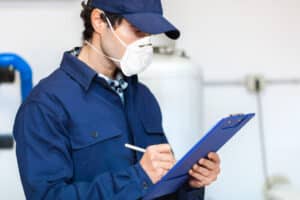Plumbing emergencies can strike at any time, often without warning, and can lead to significant damage to your home and property if not dealt with properly. As a proactive homeowner, it’s crucial to know how to handle common plumbing emergencies to minimize damage, reduce repair costs, and ensure a safe environment for you and your family.
Being knowledgeable and prepared for plumbing emergencies is one of the most important aspects of responsible homeownership. Read on as we equip you with valuable insights and tips to help you manage unexpected plumbing situations with confidence and resolve them effectively.
And, when emergency strikes, remember that our skilled and dedicated team at North Star Plumbing is here to provide you with prompt assistance, professional solutions, and outstanding service to ensure your home’s plumbing system remains in optimal condition.
Shutting Off the Water Supply: The First Line of Defense
When faced with a plumbing emergency, the first step is to shut off the water supply to minimize damage and prevent further complications. Here’s how:
1. Locate the main shutoff valve: Ensure that you know the location of your home’s main water shutoff valve, which is typically found near the water meter or in the basement.
2. Close specific valves: For localized emergencies such as an overflowing toilet or leaking sink, locate the shutoff valve near the fixture and close it by turning it clockwise.
3. Teach your household: Ensure that all members of your household know how to turn off the water supply in case of an emergency.
By promptly shutting off the water supply, you’ll effectively reduce the potential damage from a sudden plumbing issue.
Assessing and Mitigating Damage: Taking Control of the Situation
After stopping the water flow, take immediate steps to assess and mitigate any damages to your property:
1. Assess the damage: Look for pooling water, signs of water damage on walls or ceilings, and examine the affected pipes or fixtures for visible damage.
2. Remove standing water: If water has accumulated, use a wet-dry vacuum or mop to remove it and prevent further damage to floors and furniture.
3. Dry wet surfaces: Dry and ventilate affected areas to reduce the risk of mold growth and structural damage.
By quickly addressing these concerns, you’ll minimize the long-term impact of a plumbing emergency on your home.
Common Emergency Scenarios and Their Solutions
Being familiar with typical plumbing emergencies and their respective solutions will empower you to take prompt action when faced with a crisis:
1. Burst pipes: Turn off the main water supply and immediately contact a professional plumber for expert assistance in repairing or replacing the damaged pipe.
2. Overflowing toilet: Close the toilet’s shutoff valve and clear any potential blockages with a plunger. If the issue persists, seek assistance from a skilled plumber.
3. Sewer backup: Shut off the water and avoid using any plumbing fixtures. Contact a professional plumber to diagnose and remedy the problem, which may involve cleaning the sewer lines or repairing damaged pipes.
Understanding how to handle these common scenarios will help you manage emergencies effectively and protect your property from severe damage.
Preventing Future Emergencies: Proactive Measures for Homeowners
As a responsible homeowner, it’s essential to implement preventative measures to reduce the likelihood of future plumbing emergencies. Here are some useful tips:
1. Regular maintenance: Schedule routine plumbing inspections and maintenance with a trusted professional to identify and resolve potential problems before they escalate.
2. Weatherproof your pipes: Insulate and shield your pipes from extreme temperatures, particularly during the winter months, to prevent freezing and bursting.
3. Be mindful of what goes down the drain: Avoid putting grease, oil, or non-dissolvable items in your drains and toilets to prevent clogs and sewer line backups.
Taking these preventive measures will greatly reduce the risk of plumbing emergencies and contribute to the long-term health of your system.
Stay Prepared and Rely on Our Expert Assistance
Knowledge and preparedness are essential in managing plumbing emergencies effectively, minimizing damage, and ensuring a safe and comfortable living environment. By knowing how to shut off the water supply, assess and manage damage, handle common emergency scenarios, and implement preventative measures, you’ll be better equipped to protect your home and property from plumbing disasters.
For all your emergency plumbing needs in Plano, TX, trust the expertise of North Star Plumbing. Our experienced team is always available to provide swift, professional solutions and top-quality service to restore your home’s plumbing system to optimal functioning. Contact us today for any plumbing concerns, and let us help you maintain a reliable, well-functioning system for years to come.






